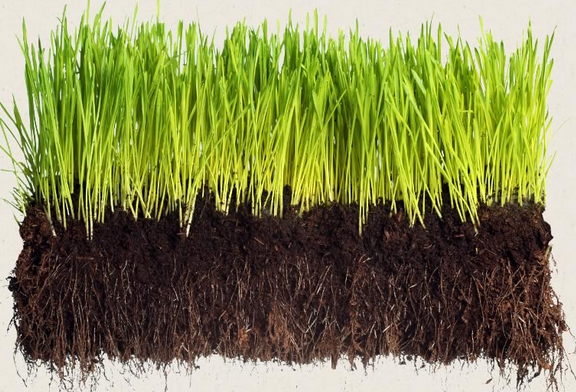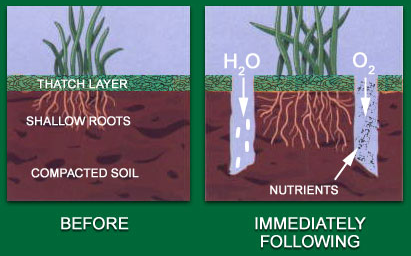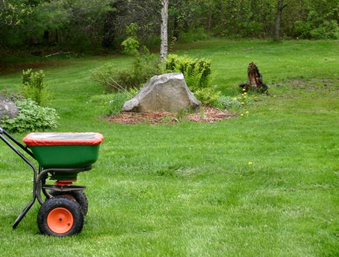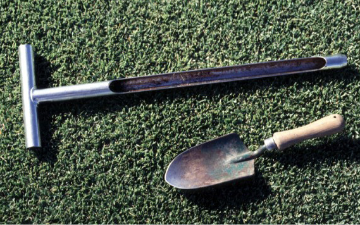A Heavenly Lawn at an Earthly Price!

Basic Northeastern Turf Management
The image to the left might not look exactly like one of our lawns, but it does tell us an awful lot about what goes
into the making of a healthy, lush lawn. Typically, New England lawns are comprised of one or more of the following types of turf:
- Bluegrass
- Rye
- Fescue
If you have ever wondered to yourself, "why does that part of my grass look different than the others?" The reason is, it is common that these three seed varieties are blended together, sometimes not blended quite enough! These three types of grasses are what are called "cold weather grasses". Obviously, due to our northeastern climate, they are resistant to cold weather. For the southern and southwestern parts of the country, "warm weather grasses" predominate: Bermuda, St. Augustine, and Zoysia. But we will focus on the first three types of turf, as they call our lawns home.
Looking again at the image to the left, one thing we can see is that the blades of the grass are tightly packed. The best defense against weeds are a tightly packed healthy lawn. Weeds grow when our lawns begin to lose their density. These insidious pests not only steal nutrients from the grass but also unfortunately spread eagerly and make it difficult for the grass to reclaim lost ground.
The second thing we might notice about the image, is that the blades of grass are of equal length to their roots. This is no coincidence. It's the rule - the length of roots are proportional to the length of the grass. Cutting our lawns too short, inhibits the root system from reaching deep into the soil to reach water and nutrients located well below the surface. But what about those lawns that look like golf courses? Constant irrigation, mowing three times a week, and abundant fertilizing can overcome the short blade-length, but that's part of the reason why golf courses charge us an arm and a leg for us to walk on them! Notice also, that the root system is somewhat loosely organized and the soil looks less firm than one might expect. Again, this is no accident. If we let our grass grow too long the root systems becomes crowded and inefficient. As for the soil, it is not hard to imagine such brittle plants having a
difficult time penetrating hard compacted soil as opposed to looser
soil. Looser soil will promote healthier root systems as well as allow
for penetration of rain water/irrigation as well as nutrients via
sunlight and soil amendments.
Looking at the grass again, it's not quite 12th fairway short, but not overly long either. It is thought in the landscaping business to keep your grass at the very lowest 2½ inches long and 5½ inches long at its peak. The rationale behind this is explained above but also through the cardinal rule of turf maintenance: never cut more than a third of the blade of grass at a time. Math will tell us, if our grass has grown to 6 inches in height, we can only safely cut off two inches to bring it back down to four inches. The grass will be in a constant state of being too long. What is the science behind this rule? Cutting more than a third,
growth will
slow as the grass puts its resources into the leaf tips to help them recover from the shock of drastic cutting.1 To follow this "one-third" rule if it ever becomes a problem, the answer is not to cut the grass shorter, but to cut it more frequently.
So what are we aiming for in our quest for a healthy lawn?
√ Grass density...it prevents weeds
√ Cut to proper length, but never more than 1/3 of the grass at a time
√ Maintain non-compacted soil...it allows for proper root growth and nutrient release into the soil
1 University of California Agriculture and Natural Resources: The UC Guide to Healthy Lawns

March-April 2017
Soil Management - Aeration
Maintaining a healthy lawn hinges on essentially four basic
steps: Mowing, feeding, weeding and aerating. If we do these steps faithfully
and let Mother Nature take care of the sun and the watering, our lawns should
be on the fast track of looking good. However, we often overlook that last step
in that four-step process. The reason is simple enough, it is the step in which
we find it hardest to actually see its benefits. But make no mistake; aerating
is just as important as the other three steps. The following article will
answer the following two questions: Why is aeration so important and how do we
do it?
So why is aeration so important to maintaining a healthy lawn? There are two
main reasons. Firstly, heavy foot traffic, the act of cutting the grass, or
even nature itself, over time, will cause our soil to begin to “put the squeeze”
on the root systems of our lawn. It’s impossible to actually see, but every
year our lawns are becoming more susceptible to what is called soil compaction. Compacted soil inhibits
your lawns root system from growing deeper into the soil and prevents nutrients
(water, fertilizer, natural supplements) from penetrating the soil and reaching
the turf's root system. Soil compaction occurs in virtually every lawn, but a new lawn
is more susceptible, as topsoil is placed over already compacted dirt during the lawn
construction process. It’s entirely natural, but preventing it from becoming a
problem is what aeration is all about.
Aeration can be done in several ways. There are two popular
(e.g. more efficient) ways in which lawn care professionals perform the task.
The first, aerating spikes and scoops can be towed behind or pushed in front of a riding mower. The second,
push or self-propelled rolling or hydro-static aerators can be used to aerate. These two devices put 2 – 3 inch holes in the ground in a 6-9 per square
foot density. Using a plug aerator, a plug of dirt removed is displaced
onto the lawn and provides a top dressing to the lawn as they break up over
time. A scoop aerator does the same job, but a uniformed "plug" of dirt left over is not present. These 2 – 3 inch holes are the key. They help alleviate the soil compaction as the walls of
the plug holes cave in upon themselves as the season progresses - loosening the soil of the yard sufficiently to promote the better root growth and nutrient absorption we are looking for!
There are
varying opinions over how often aeration should be done. Heavy traffic
areas should get done at least once per year, however once every other year is
an acceptable frequency to aerate. After aerating, it is the perfect time for
over-seeding and fertilizing, consequently, early spring and early autumn are
the ideal times to plan for aeration.
Aeration may be the most difficult process to actually see the positive result
of carrying it out, but it is definitely part of the four steps to getting your
lawn as healthy as it can be!

May - June 2017
Avoiding an "F" in Fertilizing
Few words strike as much fear into a home-owner that is dealing with their lawn maintenance than: FERTILIZER. We think mowing is the easy part; the grass gets too long, we mow it. But fertilizing not only has many more important factors to it, but it can really be overwhelming to the “science-adverse” amongst us. This article will help answer two critical questions regarding lawn fertilizing particularly: the “why’s and what’s” of fertilizing.
While it is true that your lawn’s grass will grow as nature intends it to if left uninterrupted. Bu what we want is growth AND health. There are actually quite a few factors regarding this “natural process” of growing grass that unless you looked, you would never know about. Surely we know that our lawns require sunlight and water in order to grow, but the third key factor involved in a healthy lawn is: soil nutrients. We might ask ourselves, “How come my neighbor’s lawn is healthier and greener than my lawn?” You likely get the same rainfall and roughly similar amounts of sunlight. Well here is part of your answer. The soil beneath our lawn contains natural amounts of Nitrogen, Phosphorus and Potassium. However, as years pass, your soil will deplete itself of these vital resources through use. In addition, water run-off will lower the levels of these essential nutrients to dangerous levels. This is why it is so important to amend our soil throughout the year, to replace deficient levels of these three key elements in our lawn’s soil.
Here is where the science comes in. Not to worry, you’ve already learned three key pieces of turf science and that’s all you’re going to need! Even still, our science anxiety begins to increase when we walk into our local home goods store. In the garden section we see stacks and pallets from floor to ceiling with all different brands and types of soil amendments. What is most important, however, is that we find the “right” fertilizer for our needs. On all fertilizer bags you will see three numbers, a ratio actually. For instance, a common ratio found on simple “green-up” fertilizer might be 19-0-0. What those three numbers represent are the ratios of Nitrogen to Phosphorus to Potassium (or N-P-K) contained in the fertilizer. Nitrogen is commonly the highest of the three elements as it is the most important for turf growth. Although in this example, the second and third numbers are zero, typically they will have a small, but significant value greater than zero. Phosphorus, the second number, aids in root growth and helps in fighting off disease. Potassium, the third number, is about “quality of life” for the soil. It will help in improving growth and reproduction.
There are a multitude of additional supplements contained in fertilizers, from weed control, to insect repellent, to crab grass control, but the most essential components to fertilizer are those three letters N-P-K. In our next blog we will complete our understanding of fertilizer by answering the question, "When?".
July-August 2017
Timing Fertilizer Applications
Now
that we know the why and what’s behind fertilizing, we now should consider when
should we fertilize? In many respects, this is really two questions. 1) Are
there specific issues that applying a preventative fertilizer can help address?
And 2) Are you talking about a quality if life situation for your turf?
Let’s take the first question first. There are many issues that can confront
our lawns on a year to year basis or that appear out of the blue. For instance,
is the lawn infested with broad-leaf or crabgrass? In this case, we want to use
what is known as a pre-emergent fertilizer early on in the season. Specifically
with crabgrass, once the weed begins to germinate (all it takes is 3 straight
days in which soil temperatures reach 50 degrees!) our time to prevent
crabgrass has already passed. Clover is another weed that infests many lawns in
the region. This weed thrives in a nitrogen-depleted soil, so a high-nitrogen
fertilizer is recommended. There are dozens of weeds that can rear their ugly
heads in our lawns. The key is identification and finding the appropriate
response before the problem becomes
more difficult to address.
Now what about the second question: Quality of life for our lawns. Common
practices dictate that if we are going to fertilize at all, we should aim for
at least three specifically-timed applications in what is commonly called a
Step Program. A healthy lawn can be fortified by three steps, but many lawn care
providers offer 5 or even 6 step services. Adding these extra steps is usually
part of addressing question 1 from above, but not necessarily so. As previously
explained, the first application can be early spring’s crabgrass preventer with
fertilizer. This application will help strengthen our weakened lawns coming out
of winter dormancy, as well as attend to preventing crabgrass from becoming a
problem. The second fertilizer application should occur, in the Northeast, no
later than May. Typically, we call this a “weed and feed” application.
It will buttress our lawns against the coming
heat of summer and address a broad-spectrum of broad-leaf weeds such as the
dreaded dandelion.
The fourth step will
come in late August to early September. It is simply a “lawn feeding” to help
the turf recover from a long, hot summer.
There are many additional options or steps available to further address our
lawn’s needs or avoid potential dangers. Although not fertilizers per se, many
homeowners will choose to spread grub control amendments to their lawn and some
swear by a later fall “winterizer” fertilizer that is geared to slowly feed
their soil throughout harsh New England winters.
A few parting words on fertilizer treatments. Firstly, time(ing) is of the essence. Fertilizing companies have pretty much nailed down when specific amendments should be made. Too early can be just as bad as too late. One additional comment regarding fertilizing, there is no single right program for everyone. Each lawn
has differing needs and those should be diagnosed and treated on a lawn by lawn
basis. Even your neighbor has a different lawn than you! One thing is for certain, however, there is step-program that is right just
for you.

September - October 2017
One of the most underrated things you can do for your lawn is...
...add lime. No we don't mean the tart fruit, but agricultural limestone! Although your grass WILL look that color when treated with lime.
Lime is an affordable, abundant, and useful soil amendment that helps plants and lawns prosper. It's main use is that when added to the soil it will raise low soil pH. A low soil pH, or acidic soil, is often the main culprit of an unhealthy or even simply weak lawn. Even when our healthy lawn or garden seems to be okay, liming can improve soil quality, helping plants and grass to flourish.
Liming, or adding lime to soil, has a multitude of benefits. Because liming
improves the quality of the soil, our lawns become healthier growing within a healthy soil environment. At a neutral pH, which is 7 on the 0-14 pH scale, exisiting soil
nutrients are unlocked, and readily available for plant uptake. Neutral
soil pH allows microbes and worms to prosper, organic matter to break
down, and soil to truly become the living environment it desires to be.
In addition, fertilizer is more effective at a neutral pH. When acidic
soil is corrected, plants and lawns are greener, stronger, use less
water, and are more able to resist diseases.
When and how to add lime?
The beauty of lime is that it is a very forgiving and adaptable soil amendment. It can be applied at most times of the year (avoid droughts) and is relatively safe for interaction with people, pets, and wildlife. It is still best to let slow-acting lime (pelletized) to be soaked into the soil before unrestricted use of the lawn.
It is highly recommended that you also take a soil sample of your lawn before applying lime. Although most lawns will react either neutrally or slightly positively to a small dose of lime, it is best to have a proper reading of existing soil pH in order to know just how much lime will give the greatest impact to your soil. When your soil pH is identified, simply spread the lime on the lawn with a broadcast or drop spreader until the appropriate amount of lime is applied.

March - April 2018
Spring has sprung, now what?
The calendar turns and the snows finally are receding. That's when we get our first glimpse of what our lawns look like after a long winter. There are many, many things we can do immediately once the ground is clear of the snow.
1. Clearing debris from the grass will serve two purposes: A) It will allow sunlight and nutrients to enter the soil and allow the grass to grow. B) It prevents the grass from suffocating and the formation of moss in its place.
2. What does our soil lack in nutrients after a long, cold winter? Are we Phosphorus-depleted? Do we need more Nitrogen? Is it in need of lime to replenish its pH levels? A simple soil test can provide these answers. Taking core samples from around the yard and sending them to the UMASS extension at Amherst will provide details key to the current situational needs of your lawn and soil.
3. Is our lawn full or do we see our soil in places? Putting a layer of fresh seed on the soil (together with a recommended application of starter fertilizer) will encourage new shoot growth and help thicken our lawns.
4. Has it been a long time, maybe the first time, since we have last core aerated our property? The above blog entry describes the process and benefits of doing an aeration. It's worth every penny and now is the time.
5. Have our ornamentals started budding but not yet flowering? Now is the time to trim and prune.
These are but some of the most essential questions that we should be asking.

May - June 2018
Coming soon!

